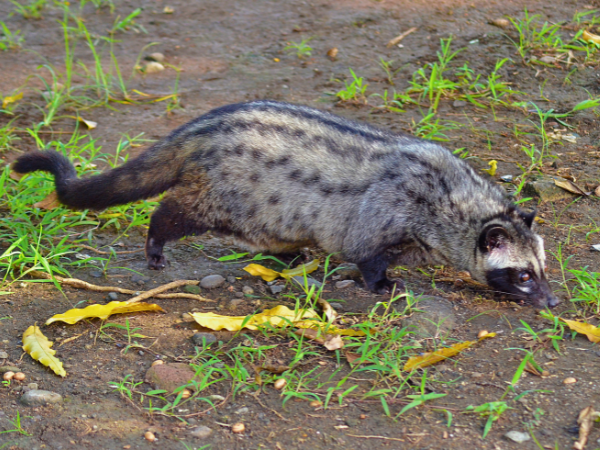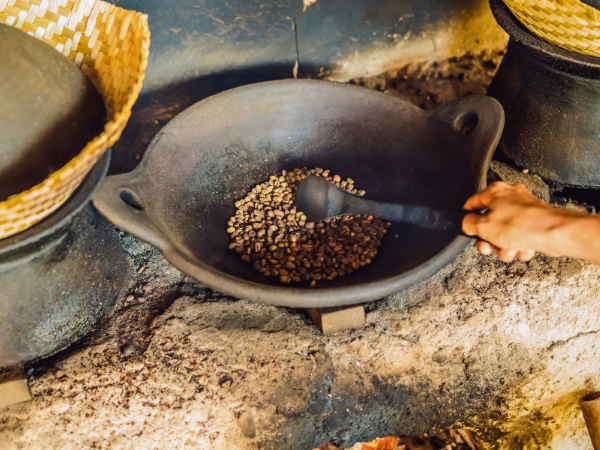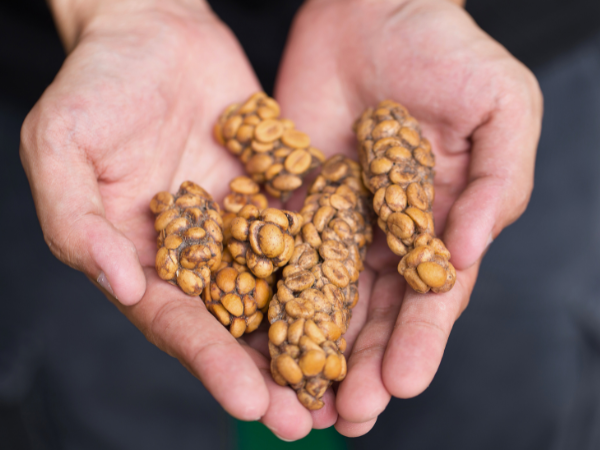Most people enjoy coffee without thinking about its origins. The journey from cherry to cup is fascinating.
One surprising player in this journey is an animal that eats coffee cherries. This animal plays a crucial role in coffee production and the ecosystem. Its actions help with seed dispersal and plant growth.
Meet The Civet: Nature’s Unexpected Coffee Harvester
The world of coffee is filled with surprises. One of the most unexpected elements in this field is the civet. This unique animal plays a vital role in coffee production by eating coffee cherries.
What Is A Civet?
The civet is a small, nocturnal mammal native to Asia and Africa. It belongs to the family Viverridae. Civets have a cat-like appearance, with long bodies and bushy tails.
Civets are solitary animals. They tend to live alone or in small groups. Here are some key features of civets:
- Size: Civets range from 60 to 90 centimeters in length.
- Diet: They are omnivores, eating fruits, insects, and small animals.
- Behavior: Civets are mostly active at night, making them nocturnal.
Civets are important in their ecosystems. They help control pest populations. Their role in coffee production is particularly interesting.
Why Civets Eat Coffee Cherries
Civets are drawn to the ripest, sweetest cherries in the wild. Their diet primarily consists of fruits, and coffee cherries are a tasty treat for them. Here’s why they choose these cherries:
- Flavor: The cherries have a sweet taste that attracts civets.
- Nutritional Value: Coffee cherries provide essential nutrients.
- Availability: They are abundant in many forested areas.
After eating the cherries, civets digest the fruit but not the beans inside. The beans pass through their system and are excreted. This process enhances the flavor of the beans.
Here’s a table summarizing the benefits of civets eating coffee cherries:
| Benefit | Description |
|---|---|
| Flavor Enhancement | The digestion process improves the flavor of the beans. |
| Natural Harvesting | Civets help in gathering ripe cherries without human intervention. |
| Eco-Friendly | Promotes biodiversity by maintaining natural ecosystems. |
Civets play a surprising yet important role in coffee production. Their unique eating habits benefit both the environment and coffee lovers worldwide.

How Civet Digestion Transforms Coffee Beans
Civets consume ripe coffee cherries and pass the beans through their digestive systems. This process transforms the beans in surprising ways.
The Fermentation Process Inside The Civet
The civet’s digestive system is key to transforming coffee beans. After eating the cherries, the beans enter the stomach. Here, they undergo a fermentation process.
- Civet saliva contains specific enzymes.
- These enzymes begin breaking down the beans.
- The beans pass through the digestive tract for several hours.
- During this time, the beans ferment with stomach acids.
- This fermentation alters the chemical structure of the beans.
Enzymes in the civet’s digestive tract alter the coffee bean. This unique process is essential for creating high-quality coffee. The beans develop flavors that are not present in normal coffee beans.
Resulting Changes In Flavor And Acidity
The fermentation process inside the civet leads to significant changes in flavor and acidity. Coffee beans that pass through a civet’s digestive system become smoother. They are less bitter than regular beans.
- Lower acidity makes the coffee easier to drink.
- Smoother texture enhances the overall experience.
- The unique taste profile includes notes of chocolate and caramel.
Understanding these changes helps us appreciate civet coffee. Each sip offers a taste of nature’s unique process. This is why civet coffee holds a special place in the world of beverages.
The Rise Of Kopi Luwak: Luxury Or Gimmick?
This unique coffee is made from beans collected after passing through a civet. Understanding its origins and costs can help you decide if it’s worth the hype.

What Is Kopi Luwak Coffee?
Kopi Luwak coffee is a unique beverage with a fascinating process. It is made from coffee beans that have been eaten and then excreted by a small mammal called the civet.
Here’s how the process works:
- The civet eats ripe coffee cherries.
- The cherries ferment in the civet’s digestive system.
- The beans are excreted and collected by farmers.
- The beans are cleaned, roasted, and brewed into coffee.
This method creates a smooth and rich flavor. Many coffee lovers seek this coffee for its unique taste. The civet’s natural selection process is believed to enhance the beans’ quality.
Price And Exclusivity
Kopi Luwak is one of the most expensive coffees due to rarity and labor. Prices can range from $100 to $600 per pound, making it a luxury item. This high cost comes from several factors:
| Factor | Impact on Price |
|---|---|
| Rarity | Limited availability of civet coffee beans. |
| Labor | Time-consuming process of collection and cleaning. |
| Quality | Unique taste profiles attract coffee enthusiasts. |
Ultimately, the decision to try Kopi Luwak depends on personal preferences. Taste, ethics, and budget all influence choices. Is it worth the splurge? Only you can decide.
Ethical Concerns And Animal Welfare
Many civets are kept in captivity for the production of kopi luwak coffee. The conditions of these captive civets often lead to serious ethical issues.

Wild Vs. Captive Civets
Wild civets roam freely in their natural habitat. They eat coffee cherries and help disperse the seeds. This process can enhance the genetic diversity of coffee plants.
In contrast, captive civets are kept in small cages. They are fed a diet of coffee cherries, often without any natural foraging opportunities. This leads to stress and poor health for the animals.
Ethical consumers should consider these differences. Support wild-sourced or ethical alternatives if available. This ensures civets can live in their natural environment, promoting animal welfare.
Sustainability And Alternatives
Alternatives to captive civet coffee exist. Sustainable coffee farms focus on ethical practices. These farms prioritize animal welfare and environmental health.
- Shade-grown coffee: Grows under tree canopies, protecting wildlife.
- Organic farming: Avoids harmful chemicals, promoting ecosystem health.
- Fair trade: Ensures fair wages for farmers and respects local communities.
By choosing these options, consumers support both the environment and ethical treatment of animals. It is crucial to research and select brands committed to sustainability.
Should You Try Civet Coffee? Pros And Cons
Many coffee lovers wonder, “Should I try civet coffee?” Let’s explore the pros and cons of this exotic brew.
Pros – Flavor And Novelty
Civet coffee is known for its rich flavor and unique taste. Here are some reasons why people enjoy it:
- Distinctive Flavor: The fermentation process in the civet’s stomach enhances the coffee’s flavor. It often has notes of chocolate and caramel.
- Low Acidity: Many drinkers find civet coffee smoother. Its lower acidity is easier on the stomach.
- Novel Experience: Trying civet coffee can be a fun story to share. It’s a conversation starter among coffee enthusiasts.
- Rarity: Civet coffee is rare. Many people enjoy trying limited or unique products.
For many, the experience of drinking civet coffee is worth the try. Its distinct flavor and novelty make it special.
Cons – Cost And Cruelty Issues
Civet coffee does have its downsides. Here are some important concerns:
- High Cost: Civet coffee is one of the most expensive coffees in the world. Prices can reach hundreds of dollars per pound.
- Ethical Concerns: Some civets are kept in captivity for coffee production. This raises questions about animal welfare.
- Quality Variability: Not all civet coffee is the same. Some brands may not provide the same quality experience.
- Environmental Impact: The demand for civet coffee can lead to habitat destruction.
The high cost and ethical issues make many think twice. Weigh these points carefully before deciding to try civet coffee.

